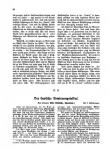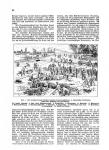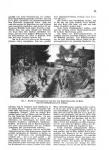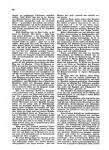-
Posts
4,908 -
Joined
-
Last visited
-
Days Won
97
Content Type
Profiles
Forums
Blogs
Gallery
Events
Store
Everything posted by Dave Danner
-
I would think fairly standard for a long-serving Prussian lower-level official such as a Lokomotivführer. My understanding is that to be eligible for the Kreuz des Allgemeinen Ehrenzeichens, which replaced the Allgemeines Ehrenzeichen in Gold in 1900, one had to already have the Allgemeines Ehrenzeichen in Silber and also at least 30 years' of service as an official or NCO, though there may have been exceptions. So the combination would fit with the 25- and 40-year railway badges.
-
Born 20 February 1891 in Wiederau, Landkreis Liebenwerda, Preußen. Wounded on 5 October 1914. No awards in any of the known rolls. Likely no decorations other than the Iron Cross, since he was a native Prussian and was in a regiment whose chief was an enemy leader (no Greek decorations to Germans during the war, for obvious reasons). Oberstleutnant on 1.2.42, so he probably has a file at the US National Archives, which are currently closed.
-
His full name was Franz Egon Gotthard Maria Ferdinand Leopold Graf Schaffgotsch. He was wounded in 1918 while serving with 6.Kompanie, Leib-Grenadier-Regiment Nr. 100. The other Graf Schaffgotsch in the Ehrenrangliste, who served in the Prussian Leib-Garde-Husaren-Regiment, was his older brother.Hans Ulrich.
-
There are two possibilities. As Andy mentions, Georg Berck, 18.11.11 Lt.d.R. (Hanau) in the reserve of IR 116, 26.4.17 OLt.d.R., then in I.Ers./IR 168. Also, Dipl.-Ing. Julius Berck, born 9.5.1884 in Darmstadt, a Ghzgl. Regierungsbaumeister. 18.8.11 Lt.d.R. (I Darmstadt, then I Essen) in the reserve of IR 168, 12.11.16 OLt.d.R., then in II.Btl./Inf.-Ers.-Truppe Warschau. Julius was wounded in Aug./Sept. 1914 with 10./IR 168 and received both the EK2 and the Hesse Bravery Medal in 1914.
-
A couple of possibly unique ones: Heinrich Ancker, who retired as a Vizeadmiral in 1942 and was then a Reichskommissar/Bundesbeauftragter in the Reichsverkehrsministerium/Bundesverkehrsministerium. Before World War I, he received the US Silver Lifesaving Medal as well as the Prussian Rettungsmedaille. Ehrenfried Freiherr v. Hünefeld, He received the US Distinguished Flying Cross in 1928. He died in 1929, so I don't know if the US medal was mounted with his World War I decorations.
-
Oh ye of little faith... Malzan, Wilhelm • born 10.12.1883 in Darmstadt • Dr. phil. (Diss. 11.6.08 Univ. Gießen) • 18.12.12 Lt.d.R. (Gießen), Inf.-Regt. Kaiser Wilhelm (2. Großherzogl. Hess.) Nr. 116 Wounded in 1914 with 3./IR 116. The ribbon below the EK2 is undoubtedly the Hessen Allgemeines Ehrenzeichen "Für Tapferkeit". There were two other Malzans commissioned as Lts.d.R. of IR 116, one in 1915 and one in 1916. One was Friedrich Malzan, also born in Darmstadt, and killed at Verdun in August 1917 with RIR 118. The other was Karl Malzan, born 22 August 1886 in Darmsadt, who received his Dr. jur. from Gießen in 1919 and was a Ministerialrat in the Reichsjustizministerium in the Third Reich. They were possibly brothers.
-
The Order of the Star of Romania is on the war ribbon and without swords. This is unusual for a German officer as most awards to Germans were with swords and on the ribbon of the Cross of Military Merit (red with blue edges). The neck badge of the Queen Maria Cross is the 1st class, not the 2nd class. As far as I know, it was not awarded with swords, so I don't know why they are there. I could be wrong, though; my Romanian references are few. Awards of the 1st Class to Germans were very rare. I have just one gazette from July 1942, and in 40 pages of awards, there are only four awards of this class of this order (three are misidentified as 3rd Class, but they are to Oberstärzte, who wouldn't have received that class). None of these four was a Luftwaffe officer, BTW. The Cross of Sanitary Merit appears to be on the correct peacetime ribbon. As you can see, the stripe colors on the actual ribbon are much darker than they appear on Lukasz's ribbon chart: See: http://www.ordersandmedals.ro/ordine-romanesti/perioada-regalista
-
Here is an excerpt from an article entitled "Der deutsche Armierungssoldat" in the Kriegsbuch für die Jugend und das Volk, published in 1915. The rest of the article: http://gmic.co.uk/uploads/monthly_09_2013/post-432-0-55748900-1380495400.jpghttp://gmic.co.uk/uploads/monthly_09_2013/post-432-0-12224600-1380495412.jpghttp://gmic.co.uk/uploads/monthly_09_2013/post-432-0-30389700-1380495423.jpghttp://gmic.co.uk/uploads/monthly_09_2013/post-432-0-10495800-1380495437.jpghttp://gmic.co.uk/uploads/monthly_09_2013/post-432-0-09424700-1380495445.jpg
-
I think the better question is how many didn't. Some of them stopped being awarded after their contingents joined the Prussian Army between 1867 and 1872, except in some cases continuing on with their local Gendarmerie. But almost every state seems to have had one. I wanted to put together a full list at one point, but I lacked pictures of some of the rarer ones, such as from Schleswig-Holstein. The Duchy of Nassau seems to be the only state which only had crosses and medals, never a Schnalle, but Nassau ceased to exist after 1866.
-
For officers, the Prussian award was given, as all officers in the Prussian Army were considered Prussian officers. This applied to active, reserve and Landwehr officers. Officers of the local Gendarmerie, however, could continue to receive the state award. For NCOs and enlisted men, as I understand it, it depended on the state. Typically, NCOs and enlisted men in state contingents continued to receive the state award. But there were exceptions, especially among the smaller states. For example, after 1867 Schwarzburg-Sondershausen only awarded its Dienstauszeichnung to the Gendarmerie, so an NCO in I./IR 71 would receive the Prussian award. But Schwarzburg-Rudolstadt continued to award its Dienstauszeichnung to both the Gendarmerie and to NCOs and men of III./IR 96. But in a further twist, NCOs of I./IR 71 could receive the silver Ehrenmedaille after 12 years' faithful service. Similarly, Lippe-Detmold dropped its Dienstauszeichnung for NCOs and men after 1867 while Schaumburg-Lippe kept its until 1918. This is a topic I don't really understand fully, since my focus has been on combat decorations, so I would also welcome any corrections or additional information.
-
There is nothing on the Web, to my knowledge. For just such questions, I made a list of every wartime unit, and then went through various sources such as Formationsgeschichten, regimental histories, casualty lists, intelligence reports, award lists, etc. to determine how these units were related to various states.
-
For what it's worth, there were mixed Ghzgl. Badisch and Hessisch units, among them IR 389 and IR 418. But I agree it is more likely simply a native of one state serving in the contingent of the other. Baden and Hessen border each other, so mixing was common. Since the Hessen ribbon is before the Baden ribbon, he was more likely a native of Hessen. A typical scenario would be a native of Hessen who went to university in Baden (Heidelberg or Freiburg) and did his one-year volunteer service in a Baden regiment, remaining in that unit as a reserve officer. Heidelberg seems likely, since the closest village in Hessen to the University of Heidelberg, Neckarsteinach, is just 10 kilometers from the school. Indeed, Darmstadt is just 50 km away from Heidelberg and thus 30 km closer to Heidelberg than to Hessen's own university in Giessen. Both grand duchies' contingents were part of the Prussian Army, so a Prussian long service would fit. Are you certain that there was never a device? Because a swastika device for a Treuedienst-Ehrenzeichen would certainly make sense for a wartime Lt.d.R. who returned to the civil service after the war. Though an LD2 would also make sense, if he was in the army for long enough before the war. And might also fit if he was too old to be recalled in World War Two but get the KVK2 for something on the homefront.
-
Not knowing anything about uniforms, I agree DR 20 makes sense for Karlsruhe. Still, they are in front of LGR 109's Kaserne, not DR 20's, which was two blocks to the south. There used to be a park behind the DR 20 Kaserne, between the Hilda Promenade and Moltkestrasse. I suppose they assembled in the park for the photo.
-
The postcard was sent from Karlsruhe, but it was sent to his brother in Niederflockenberg in Westphalia. By 1916, IR 20, like many Prussian regiments from rural areas, had received numerous replacements from more populous areas like Westphalia and the Rhineland. By the way, it appears that the photo was taken in front of the Grenadier-Kaserne in Karlsruhe, home of Baden's Leib-Grenadier-Regiment Nr. 109. Here is a picture of that Kaserne from a few weeks ago:
-

Heer Keitel, Bodewin
Dave Danner replied to hucks216's topic in Germany: All Eras: Signature Database
-
Alfred Kaltenegger, born 17 February 1874. "Am 8.1.15 in der Stellung bei Dompierre durch Inf.Schuß am Kopf leicht verwundet." Also Scarhip: "Am 16.8.14 bei Gondrexange durch einen Stich mit dem Seitengewehr in die rechte Hüfte leicht verwundet." After that, it says "(Versehen eines Mannes)". Does that mean one of his own men accidentally stabbed him?









